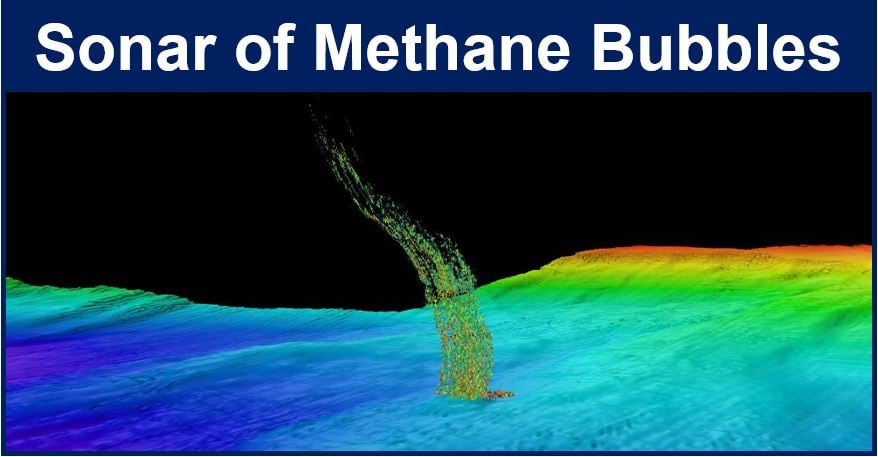Subsurface sea warming is thawing frozen methane, which is finding its way to the surface and into our atmosphere, researchers from the University of Washington reported.
A third of a mile below the ocean’s surface the water is cold; so cold that frozen pockets of methane ‘ice’, a powerful greenhouse gas, lie dormant – that is, until recently.
Scientists, who published their findings in the journal Geochemistry, Geophysics, Geosystems (citation below), say that subsurface warming may be causing more methane gas to bubble up off the Oregon and Washington coast.
They have observed 168 bubble plumes over the past ten years, which is a ‘disproportionate number’.
 Sonar image of methane bubbles rising from ocean floor off Washington coast. (Source: University of Washington. Credit: Brendan Philip)
Sonar image of methane bubbles rising from ocean floor off Washington coast. (Source: University of Washington. Credit: Brendan Philip)
Lead author H. Paul Johnson, a UW professor of oceanography, said:
“We see an unusually high number of bubble plumes at the depth where methane hydrate would decompose if seawater has warmed. So it is not likely to be just emitted from the sediments; this appears to be coming from the decomposition of methane that has been frozen for thousands of years.”
Historically, methane gas has been known to contribute to sudden swings in Earth’s climate. We do not know what role this gas might play in contemporary climate change, although recent studies have reported methane emissions, related to warming, off the Atlantic coast and Arctic permafrost.
Of the 168 methane plumes observed, fourteen were located at the transition depth – more plumes per unit area than found on surrounding parts of the Oregon and Washington seafloor.
Methane is a powerful greenhouse gas
If methane bubbles make their way to the ocean’s surface, they enter our atmosphere and act as a potent greenhouse gas.
However, during their journey up to the surface, most of the deep-sea methane appears to get consumed by marine microbes, which convert it into carbon dioxide. This creates a more acidic, lower-oxygen environment in the deeper offshore water. The carbon dioxide eventually wells up along the coast and surges into coastal waterways.
Prof. Johnson said:
“Current environmental changes in Washington and Oregon are already impacting local biology and fisheries, and these changes would be amplified by the further release of methane.”

Seafloor slopes may be affected
There is also concern that the seafloor slopes may become destabilized. The frozen methane acts as a glue, Johnson explains, that holds the steep sediment slopes in place.
The continental margin of the Pacific Northwest coast has abundant methane deposits. A UW study published last year showed that the ocean in the region is warming at a depth of one third of a mile (500 meters), by water that formed several years ago in a global warming hotspot off Siberia and then made its way with ocean currents eastward across the Pacific Ocean.
That study calculated that warming at that depth should destabilize methane deposits on the Cascadia subduction zone, which stretches from Vancouver Island to northern California.
The cold temperature and high pressure present on the continental margin makes the methane gas on the seafloor sediments form a crystal lattice structure with water. This ice-like solid, known as methane hydrate, is very unstable and extremely sensitive to temperature changes.
When the ocean gets warmer, the hydrate crystals dissociate, causing methane gas to leak into the sediment. Some of that methane escapes from the sediment pores as a gas.
The team involved in last year’s study calculated that such hydrate decomposition could release approximately 0.1 million metric tons of methane annually into the sediments off the Washington coast. This is roughly equivalent to the amount of methane from the 2010 Deepwater Horizon blowout.
This latest study looked at evidence of bubble plumes off the coast, including observation by UW research cruises, local fishermen’s reports and earlier studies.
The scientists included bubble plumes that rose at least 490 feet (150 meters) tall that clearly originate from the seafloor.
Plumes more common at 500 meters below surface
Their dataset also included 45 plumes that fishing boats had originally detected while looking for schools of fish. Modern sonars can detect the bubbles.
Their results showed that methane gas is slowly released at nearly all depths along the Oregon and Washington coastal margin. However, the plumes are much more common at the critical depth of 500 meters, where hydrate would decompose because of the warmer seawater.
Prof. Johnson said:
“What we’re seeing is possible confirmation of what we predicted from the water temperatures: Methane hydrate appears to be decomposing and releasing a lot of gas. If you look systematically, the location on the margin where you’re getting the largest number of methane plumes per square meter, it is right at that critical depth of 500 meters.”
Nobody yet knows for certain whether these plumes are really from the dissociation of frozen methane deposits.
Co-author Evan Solomon, a UW associate professor of oceanography, said:
“The results are consistent with the hypothesis that modern bottom-water warming is causing the limit of methane hydrate stability to move downslope, but it’s not proof that the hydrate is dissociating.”
Prof. Solomon is currently analyzing the chemical composition of the samples of bubble plumes emitted by sediments along the Washington coast 500 meters below the surface. The results will determine whether the gas came from the methane hydrate or some other source, such as the passive migration of methane from further down in the seafloor.
The study was funded by the US Department of Energy and the National Science Foundation.
Citation: “Analysis of bubble plume distributions to evaluate methane hydrate decomposition on the continental slope,” H. Paul Johnson, Una K. Miller, Marie S. Salmi and Evan A. Solomon. Geochemistry, Geophysics, Geosystems, October 2015. DOI: 10.1002/2015GC005955.
